In front of me you can see four models of the same two lumbar vertebrae, presented as textbook normal and phase 1, 2 and 3 of spinal degeneration. This is also known as osteoarthritis (osteo meaning bone), degenerative disc disease, or commonly wear and tear.
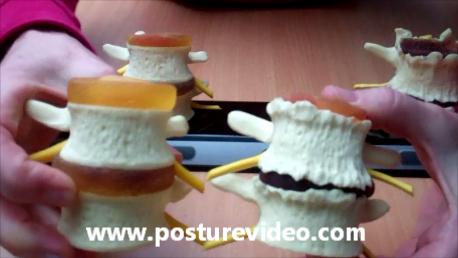
I don’t like euphemisms. I think you can handle the truth and that like me, you probably don’t like being talked down to. So let’s call it what it is … osteoarthrtis or degenerative discs or spinal arthritis.
Free Posture Crash Course!
Discover the crazy, simple 3-step formula that will teach you how to improve your posture and flexibility like a pro. You will learn how to hardwire the habit of good posture, reduce forward head and the secret way to stop slouching. It's 100% free!
A normal lumbar segment has two vertebra and a healthy cartilage disc in between. If you look at the disc from the top, you can see that the gelatinous or gel-like toothpaste substance, is well contained within the cartilage rings of the disc.
There should also be good symmetrical bony alignment. You may choose to have a chiropractor detect whether or not you have any spinal misalignments. Early on, these subluxations are easily detected and corrected.
A normal spinal segment will also have healthy nerve roots. Lots of space for them to communicate with the body (your organs, bloodvessels and glands). Because our nervous system runs our body, we don’t want any interference from misaligned vertebra (poor posture) or degenerative discs.
Incorrect Posture May Cause Degeneration
Asymmetry in the body (incorrect posture) can lead to early degenerative changes. Posture is so much more than what we see on the outside of our body.
Phase 1
In Phase 1 of spinal degeneration, we may start to see wear in the discs. Evidenced only on MRI imaging, this is a kind of dehydration that occurs in the cartilage tissues..
The rings of cartilage that make up our spinal discs, start to break down. The gelatinous center begins to dry out, a little bit like the toothpaste that is stuck around the outside of the cap. There are likely no effects as yet (or mild effects) to your nerve system.
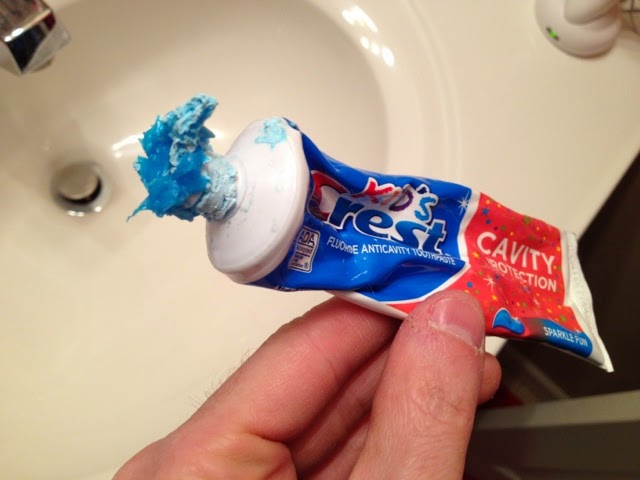
These people may not present with health problems at this early stage, or they may have some mild symptoms.
Phase 2
After a decade with incorrect posture from poor habits, childhood injuries, athleticism and manual labouring, it is more common to see people with Phase 2 degenerative changes.
Typically, discs are now very dehydrated. The gelatinous nucleus (the toothpaste-like substance) has often leaked right through the dried out cracks in the cartilage rings, that buldge into the space where the spinal cord lives. This is known as a slipped or herniated disc.
There is often nerve irritation in Phase 2. These people often present with leg pain (sciatica); as the nerves that exit the lower lumbar segments, travel through the buttocks and down the leg.
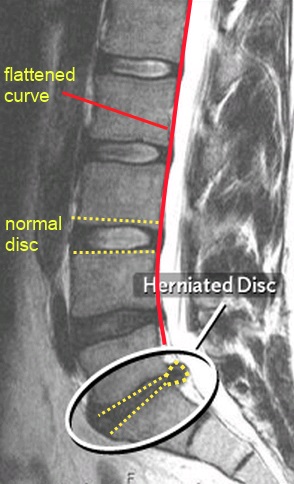
Further Resources: Sciatic Leg Pain Relief
They may also present with other health issues (bowel and bladder troubles), as these nerve roots supply our organs, blood vessels and glands in the pelvic region.
In Phase 2, the vertebral bones get closer together, and the ligaments and muscles become slack. There is now excess movement in the bony segments. They have become unstable, and the body responds by laying down more calcium to stabilise the segment. These calcium deposits or bone spurs aren’t generally painful, but lead to stiffness.
Morning stiffness is a strong indicator of spinal degeneration. After waking, it may take a few hours before a person with Phase 2 degeneration feels mobile.
Phase 3
After a several decades with incorrect postural alignment, past accidents, poor lifestyle, we begin to see advanced arthritic (degenerative) changes. In Phase 3, the discs have completely dried up and can lead to total bony fusion between the vertebral segments of the spine.
Not only is this person extremely stiff, but their spinal segments no longer move independently. This person surprisingly, is often without pain but they are extremely stiff and immobile.
Phase 1, 2 and 3 can only be diagnosed by x-ray and/or MRI. X-Ray imaging show us bony changes and MRI show tissue changes. MRI is the imaging of choice for degenerative disc diagnosis, and x-ray imaging is gold standard for alignment and postural diagnosis.
If you have been diagnosed with wear and tear without an x-ray, you have been done a disservice, in my opinion. A good practitioner can probably accurately guess your diagnosis from signs, symptoms and examination, but they will never be able to accurately assess whether you are in Phase 1, 2 or 3. This is why I would never practice without on-site x-ray facilities.
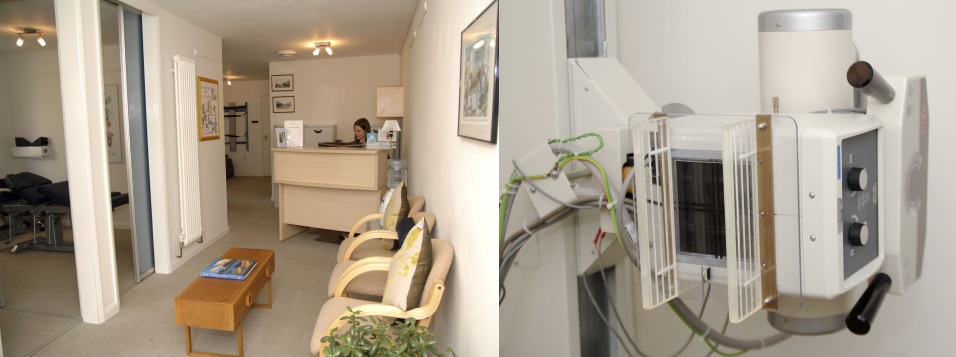
A person with Phase 3 may present with multiple health issues because the nerve roots are usually seriously comprised in this phase of degeneration.
Obviously the right time to start paying attention to your posture is at the stage of postural misalignments – before the discs and nerve roots become compromised. While it is never too late to start creating a healthy posture habit for life, the longer we put off getted started, the more likely we are to enter Phase 1, making improvements more challenging and time consuming.
If I can correct and improve my posture, given my bunion (argh), anatomical short leg, lumbar scoliosis and disc degeneration, anyone can. But please start today!

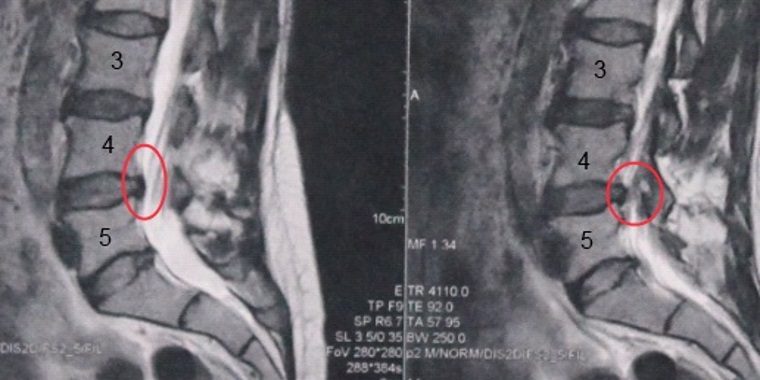



6 thoughts on “Morning Stiffness | Do You Have Wear & Tear?”
Good article ..thanks
I enjoy reading your research … it is soo practical.
After much “wear and Tear” I need one or both hips updated, I plan to have the first done within the next month. I have had terrible forward pelvic tilt .. I hope the new hip and your classes will get me on the posture recovery road.
Thanks … Mike Singer
Hi Mike,
Thank you for saying that. You have no idea how much of a compliment that is for me. ‘So practical’ is right in line with one of my core values in life; which is SIMPLICITY. I write from that place.
Keep an eye out for my new Posture School Membership – it will be a club of sorts for us like minded individuals who are motivated to improve!
Paula
Thanks so much for your informative videos and courses. I am 54, have been living a healthy lifestyle, do yoga, swimming and walking as exercise. I thought I was doing all the right things to stay fit and healthy but recently I have been experiencing stiffness and pain first thing in the morning. It is a whole body thing, fingers (stiff and hard to bend), feet (developed plantar fasciitis) and stiffness in my back. It only lasts for 5 to 10 minutes and then I am fine again. It has taken me by surprise and I don’t like where it is heading. I am doing your courses on Udemy to improve my posture (rounded upper back, forward head). What else could I do to slow this process down? Is it hereditary? I remember my father having trouble with getting up too. Many thanks again. I enjoy receiving your emails! Greetings from Australia.
Hello Lin,
Thank you for your message. We are close in age (you are slightly in the lead), and I know what it is like to hit the 40-something wall and wake one day to say: ‘Hey, i’m not 30 any longer.’ Argh!! If only.
The first step Lin is to get a structural diagnosis. Too often men and women over 40 just push through, trying one exercise program and another; various ‘classes’, personal trainers etc. etc. All of my over 40 patients in my years in private practice got spinal x-rays, because I know that after several decades weight bearing, years of prolonged sitting and various accidents (many we don’t even remember), this often leads to some degeneration. It is much more about the number of years on this planet, than it is genetics. Genetics has very little really, to do with it.
Most of the students I work with, start with a skype consultation. That gives us the time to delve into your health history – you’d be suprised what I often uncover. It also helps me to point you in the best direction, so you don’t end up on the wheel of trying everything, only to end up where you started a year later.
If you are interested, you can book a skype chat with me here: http://www.posturevideos.com/product/skype-consultation/
In the meantime, keep an eye on my blog; next week there will be an article (and video) on plantar fasciitis!
Paula